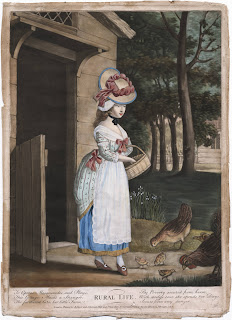Yesterday afternoon I decided to do a quick post on the three basic accessories; caps, kerchiefs, and aprons. I took a few images of my caps, started to cut a new one out to show shapes, and then decided to find a few quick images for examples. That's when I realized that caps tend to be an object we always use secondary sources for. Most of my examples have been from commercial patterns, others examples, and "how-to" guides for patterning your own. So, I skipped the posting and spent some time trying to find images and drawings of actual caps. Easier said than done. Oh, you find them in many artworks of the time, but they are hardly ever clear enough to make something from.
So, here is what I've accumulated. It's mainly focused on the ruffled cap. I'll show my examples and progress tomorrow or Friday.
The Lewis Walpole Library has a selection of images which seem to show an abundance of clear caps:
Then onto extant examples. Much harder to find, not surprisingly. The Met seemed to have a decent number, although most were labelled 1700-1941. MFA had many that were labelled, only a few were adult caps however. I'm still searching in other databases, let me know if you come across any good examples and I'll try to add them in!
This is probably the best example I could find to compare to the above images. It doesn't peak up in the center like most of them do, but it's very similar. A broad date of 1750-1850 doesn't help much.
Another ruffled cap, dated 1750-1850 again. An unusually wide hem on the ruffles.
This example seems to be shaped with darts in the very back. Dated 1750-99.
A cap entirely made of narrow strips of lace sewn together.
I'm not exactly sure how this would appear when worn, but I'm curious now. It has a number of drawstrings along it and is shirred very finely at the back. This example and another are very similar in style.
A very fluffy example, from the Met, dating 1790-1804. A little late for my time period, but a good example of a round caul and no band.
So, here is what I've accumulated. It's mainly focused on the ruffled cap. I'll show my examples and progress tomorrow or Friday.
The Lewis Walpole Library has a selection of images which seem to show an abundance of clear caps:
Then onto extant examples. Much harder to find, not surprisingly. The Met seemed to have a decent number, although most were labelled 1700-1941. MFA had many that were labelled, only a few were adult caps however. I'm still searching in other databases, let me know if you come across any good examples and I'll try to add them in!
This is probably the best example I could find to compare to the above images. It doesn't peak up in the center like most of them do, but it's very similar. A broad date of 1750-1850 doesn't help much.
Another ruffled cap, dated 1750-1850 again. An unusually wide hem on the ruffles.
This example seems to be shaped with darts in the very back. Dated 1750-99.
A cap entirely made of narrow strips of lace sewn together.
I'm not exactly sure how this would appear when worn, but I'm curious now. It has a number of drawstrings along it and is shirred very finely at the back. This example and another are very similar in style.
A very fluffy example, from the Met, dating 1790-1804. A little late for my time period, but a good example of a round caul and no band.
This example is a little earlier, dated 1785-98. It also has a round caul, but is more of a lappet style. The museum labels it as a Mobcap.
Late 18th or early 19th century cap, very simple in design. The very back has a separate arc shaped piece rather than gathers to shape it. Another example here shows that more clearly.























































